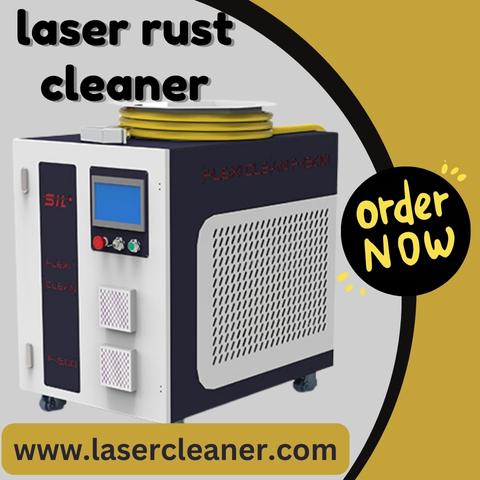Rust has always been a challenge for industries that work with metal equipment, machinery, vehicles, or tools. Traditional rust removal methods such as sandblasting, chemical cleaning, and mechanical grinding not only consume time but also involve significant wear and tear on equipment. In recent years, the laser rust cleaner has emerged as a modern solution, offering efficiency, precision, and environmental safety for diverse applications.
Unlike abrasive or chemical methods, a laser rust cleaner uses a focused laser beam to vaporize rust, paint, or contaminants from a surface. This contact-free approach makes it suitable for both delicate and heavy-duty cleaning jobs. With industries constantly seeking methods that reduce downtime and improve accuracy, the laser rust cleaner stands out as a dependable choice.
How the Laser Rust Cleaner Works
The operating principle of a laser rust cleaner lies in its ability to deliver high-energy laser pulses to a targeted surface. When these pulses hit the rust or contaminants, the unwanted material absorbs the energy and evaporates or breaks apart, leaving the base metal intact.
This process is highly controlled, as the laser wavelength is adjusted according to the type of rust or surface material. It ensures that only the unwanted layer is removed, without causing structural damage to the underlying material.
This non-contact cleaning approach makes the laser rust cleaner suitable for precision industries, including aerospace, automotive, electronics, and even heritage conservation.
Applications Across Different Sectors
A laser rust cleaner is not limited to one type of industry; its versatility has made it a reliable tool across multiple sectors.
-
Automotive Industry
Car manufacturers and repair workshops face frequent challenges with rust. A laser rust cleaner helps in preparing metal parts for painting, welding, or coating. It also restores old vehicle components by removing rust without altering the dimensions of the part. -
Shipbuilding and Marine
Ships and marine equipment constantly battle corrosion due to saltwater exposure. A laser rust cleaner helps maintain ship hulls, propellers, and other steel structures. Unlike abrasive methods, it prevents surface weakening and prolongs the life of marine assets. -
Aerospace
Aircraft maintenance demands the highest level of precision. The laser rust cleaner is used for cleaning sensitive components without affecting their geometry. It ensures safety and compliance with strict industry standards. -
Manufacturing Plants
Industrial machinery and production lines often experience rust build-up, leading to inefficiency. By using a laser rust cleaner, operators can quickly restore machines and ensure smooth production flow. -
Cultural Heritage and Restoration
Historical monuments, sculptures, and artifacts made of metal are often at risk of corrosion. A laser rust cleaner removes rust layers carefully without damaging the original structure, making it a trusted tool in restoration projects.
Why Industries Trust the Laser Rust Cleaner
Industrial cleaning is about more than just surface appearance. It directly affects operational efficiency, equipment longevity, and overall safety. The laser rust cleaner provides a modern approach that aligns with these industrial priorities.
-
Efficiency: Cleaning is faster and more consistent compared to traditional techniques.
-
Precision: Surfaces are cleaned with high accuracy, even in complex geometries.
-
Reduced Downtime: Machines and equipment can be cleaned in place, minimizing production interruptions.
-
Eco-Friendly Process: Since it avoids chemicals, the laser rust cleaner supports sustainability goals.
These factors make it a preferred choice for businesses that prioritize long-term reliability and cost-effective operations.
Safety Considerations in Using a Laser Rust Cleaner
Operating a laser rust cleaner requires proper training and adherence to safety guidelines. The equipment emits high-intensity light, so operators must wear protective gear such as laser safety glasses. Controlled environments and proper shielding also ensure safe operation.
Manufacturers provide different models of laser rust cleaners, ranging from handheld portable systems to large automated setups. Regardless of the model, strict compliance with safety standards is essential to protect both workers and the surrounding environment.
Future of Laser Rust Cleaning Technology
The adoption of laser rust cleaners is growing rapidly as more industries recognize their value. The ongoing research and development in laser technology is making these devices more compact, powerful, and cost-efficient.
We are witnessing a shift where companies are moving away from abrasive and chemical processes to embrace sustainable alternatives. Laser rust cleaners are at the heart of this transformation, bridging the gap between performance and environmental responsibility.
As industries continue to evolve, laser cleaning is expected to become a standard practice. From automated robotic systems to AI-integrated monitoring, the future holds promising advancements that will make laser rust cleaning even more accessible and effective.
Case Example: Automotive Plant Adoption
One automotive plant faced recurring issues with rust buildup on steel frames before painting. The traditional sandblasting method was slow, messy, and required significant labor. After adopting a laser rust cleaner, the plant reported:
-
A 40% reduction in cleaning time.
-
Improved adhesion of paint coatings.
-
Lower maintenance costs due to non-abrasive cleaning.
-
A safer working environment by eliminating chemicals and dust exposure.
This example highlights how industries benefit in both performance and sustainability by adopting laser-based cleaning.
Cost Perspective
Many businesses initially view a laser rust cleaner as an expensive investment. However, when compared with the recurring costs of consumables, labor, and downtime in traditional methods, the long-term value becomes evident.
A single device can replace multiple cleaning processes, minimize consumable usage, and extend the life of metal components. Over time, companies save on both operational and maintenance expenses, making the investment financially sound.
Final Thoughts
The laser rust cleaner is no longer just an advanced technology reserved for specialized industries. It is becoming a mainstream solution for businesses that demand reliable, safe, and sustainable cleaning methods. With its ability to deliver precise results, reduce downtime, and eliminate the need for chemicals or abrasives, it offers a clear pathway for industries looking to modernize their operations.
As companies focus on efficiency, safety, and sustainability, the laser rust cleaner stands as a tool that addresses all these requirements simultaneously. Its growing adoption signals a strong future where laser-based cleaning will play a central role in industrial processes worldwide.

